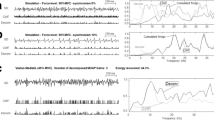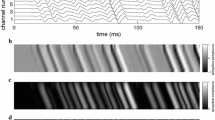Abstract
The aim of the study was to compare experimentally, on the basis of single motor unit (MU) activities, the selectivity of different spatial filters commonly used to detect surface electromyogram (EMG) signals. Surface EMG signals were recorded from the biceps brachii and the upper trapezius muscle of five subjects using a two-dimensional (2D) electrode array consisting of 16 pin electrodes. The subjects performed isometric contractions at different elbow angles and shoulder abduction and flexion. The same monopolar surface EMG signals were filtered using longitudinal single and double differential, transverse single and double differential and normal double differential filters. From the single MU action potentials, extracted by automatic EMG decomposition, indexes of transverse (perpendicular with respect to the fibre direction) and longitudinal (along the fibre direction) selectivity were computed. The number of detected MUs was 48 for the upper trapezius, with the arms held in the sagittal plane, and 52 when the arms were held in the frontal plane; 85 MUs were identified from the biceps brachii contractions. The results showed that transverse selectivity was significantly higher for the 2D and transverse onedimensional (1D) filters with respect to the 1D longitudinal filters, whereas longitudinal selectivity was higher (i.e. MU action potentials were shorter) for the 2D filter and the longitudinal double differential filter. In particular, the relative attenuation of potential amplitude moving 5 mm from the source was, on average (for the two muscles), 16.5% for the least selective filter in the transverse direction (longitudinal single differential) and 35.7% for the most selective one in the same direction (transverse double differential). The MU action potential duration was, on average, 13.8 ms for the most selective filter in the longitudinal direction (longitudinal double differential) and 18.7 ms for the least selective one (transverse double differential). The normal double differential filter resulted in spatial selectivity indexes that were not statistically different in the two directions from those of the best filters in each direction.
Similar content being viewed by others
References
Disselhorst-Klug, C., Silny, J., andRau, G. (1997): ‘Improvement of spatial resolution in surface-EMG: a theoretical and experimental comparison of different spatial filters’,IEEE Trans. Biomed. Eng.,44, pp. 567–574
Disselhorst-Klug, C., Silny, J., andRau, G. (1998): ‘Estimation of the relationship between noninvasively detected activity of single motor units and their characteristic pathological changes by modelling’,J. Electromyogr. Kinesiol.,8, pp. 323–335
Disselhorst-Klug, C., Rau, G., Schmeer, A., andSilny, J. (1999): ‘Non-invasive detection of the single motor unit action potential by averaging the spatial potential distribution triggered on a spatially filtered motor unit action potential’,J. Electromyogr. Kinesiol.,9, pp. 67–72
Disselhorst-Klug, C., Bahm, J., Ramaekers, V., Trachterna, A., andRau, G. (2000): ‘Non-invasive approach of motor unit recording during muscle contractions in humans’,Eur. J. Appl. Physiol.,83, pp. 144–150
Dumitru, D., andKing, J. C. (1991): ‘Far-field potentials in muscle’,Muscle & Nerve,14, pp. 981–989
Farina, D., andRainoldi, A. (1999): ‘Compensation of the effect of sub-cutaneous tissue layers on surface EMG: a simulation study’,Med. Eng. Phys.,21, pp. 487–496
Farina, D., andCescon, C. (2001): ‘Concentric ring electrode systems for non-invasive detection of single motor unit activity’,IEEE Trans. Biomed. Eng.,48, pp. 1326–1334
Farina, D., Cescon, C., andMerletti, R. (2002a): ‘Influence of anatomical, physical and detection system parameters on surface EMG’,Biol. Cybern.,86, pp. 445–456
Farina, D., Fosci, M., andMerletti, R. (2002b): ‘Motor unit recruitment strategies investigated by surface EMG variables’,J. Appl. Physiol.,92, pp. 235–247
Farina, D., Madeleine, P., Graven-Nielsen, T., Merletti, R., andArendt-Nielsen, L. (2002c): ‘Standardising surface electromyogram recordings for assessment of activity and fatigue in the human upper trapezius muscle’,Eur. J. Appl. Physiol.,86, pp. 469–478
Farina, D., Merletti, R., Indino, B., Nazzaro, M., andPozzo, M., (2002d): ‘Cross-talk between knee extensor muscles. Experimental and model results’,Muscle & Nerve,26, pp. 681–695
Gydikov, A., Kosarov, D., andDimitrov, G. V. (1979): ‘Length of the summated depolarized area and duration of the depolarizing and repolarizing processes in the motor unit under different conditions’,Electromyogr. Clin. Neurophysiol.,19, pp. 229–248
Hermens, H. J., andFreriks, B. (1997): ‘The state of the art on sensors and sensor placement procedures for surface electromyography: a proposal for sensor placement procedures’. SENIAM Project Report, Roessingh Research & Development (Pub.)
Hogrel, J. Y., andDuchêne, J. (1999): ‘A sEMG-based system for clinical applications using laplacian electrodes’. Proc. of the 4th General SENIAM Workshop, The Netherlands, pp. 172–177
Huppertz, H. J., Disselhorst-Klug, C., Silny, J., Rau, G., andHeimann, G. (1997): ‘Diagnostic yield of noninvasive high-spatial-resolution-EMG in neuromuscular disease’,Muscle & Nerve,20, pp. 1360–1370
Jensen, C., Vasseljen, O., andWestgaard, R. H. (1993): ‘The influence of electrode position on bipolar surface electromyogram recordings of the upper trapezius muscle’,Eur. J. Appl. Physiol.,67, pp. 266–273
Masuda, T., Miyano, H., andSadoyama, T. (1985): ‘A surface electrode array for detecting action potential trains of single motor units’,Electroenceph. Clin. Neurophysiol.,60, pp. 435–443
Merletti, R., Farina, D., andGranata, A. (1999): ‘Non-invasive assessment of motor unit properties with linear electrode arrays’, in ‘clinical neurophysiology: from receptors to perception’ (Elsevier Publisher, 1999), pp. 293–300
Ramaekers, V., Disselhorst-Klug, C., Schmeider, J., Silny, J., Forst, J., Forst, R., Kotlarek, F., andRau, G. (1993): ‘Clinical application of a noninvasive multi-electrode array EMG for the recording of single motor unit activity’,Neuropaediatrics,24, pp. 134–138
Rau, G., Disselhorst-Klug, C., andSilny, J. (1977): ‘Noninvasive approach to motor unit characterization: muscle structure, membrane dynamics and neuronal control’,J. Biomech.,30, pp. 441–446
Rau, G., andDisselhorst-Klug, C.,(1997): ‘Principles of highspatial-resolution surface EMG (HSR-EMG): single motor unit detection and application in the diagnosis of neuromuscolar disorders’,J. Electromyogr. Kinesiol.,7, pp. 233–239
Reucher, H., Rau, G., andSilny, J. (1987a): ‘Spatial filtering of noninvasive multielectrode EMG: part I—Introduction to measuring technique and applications’,IEEE Trans. Biomed. Eng.,34, pp. 98–105
Reucher, H., Rau, G., andSilny, J. (1987b): ‘Spatial filtering of noninvasive multielectrode EMG: part II—Filter performance in theory and modelling’,IEEE Trans. Biomed. Eng.,34, pp. 106–113
Roeleveld, K., Stegeman, D. F., Vingerhoets, H. M., andvan Oosterom, A. (1997): ‘The motor unit potential distribution over the skin surface and its use in estimating the motor unit location’,Acta Physiol. Scand.,161, pp. 465–472
Schulte, E., Farina, D., Disselhorst-Klug, C., Merletti, R., andRau, G. (2002): ‘Non-invasive estimation of motor unit conduction velocity during isometric and dynamic contractions’. Proc. XIV Congress of International Society of Electrophysiology and Kinesiology, pp. 171–172
Schulte, E., Farina, D., Rau, G., Merletti, R., andDisselhorst-Klug, C. (2003): ‘Single motor unit analysis from spatially filtered surface electromyogram signals. Part 2: Conduction velocity estimation’,Med. Biol. Eng. Comput.,41, pp. 338–345
Wee, A. S., andAshley, R. A. (1990): ‘Volume-conducted or “far-field” compound action potentials originating from the intrinsic-hand muscles’,Electromyogr. Clin. Neurophysiol.,30, pp. 325–333
Author information
Authors and Affiliations
Corresponding author
Rights and permissions
About this article
Cite this article
Farina, D., Schulte, E., Merletti, R. et al. Single motor unit analysis from spatially filtered surface electromyogram signals. Part I: Spatial selectivity. Med. Biol. Eng. Comput. 41, 330–337 (2003). https://doi.org/10.1007/BF02348439
Received:
Accepted:
Issue Date:
DOI: https://doi.org/10.1007/BF02348439




